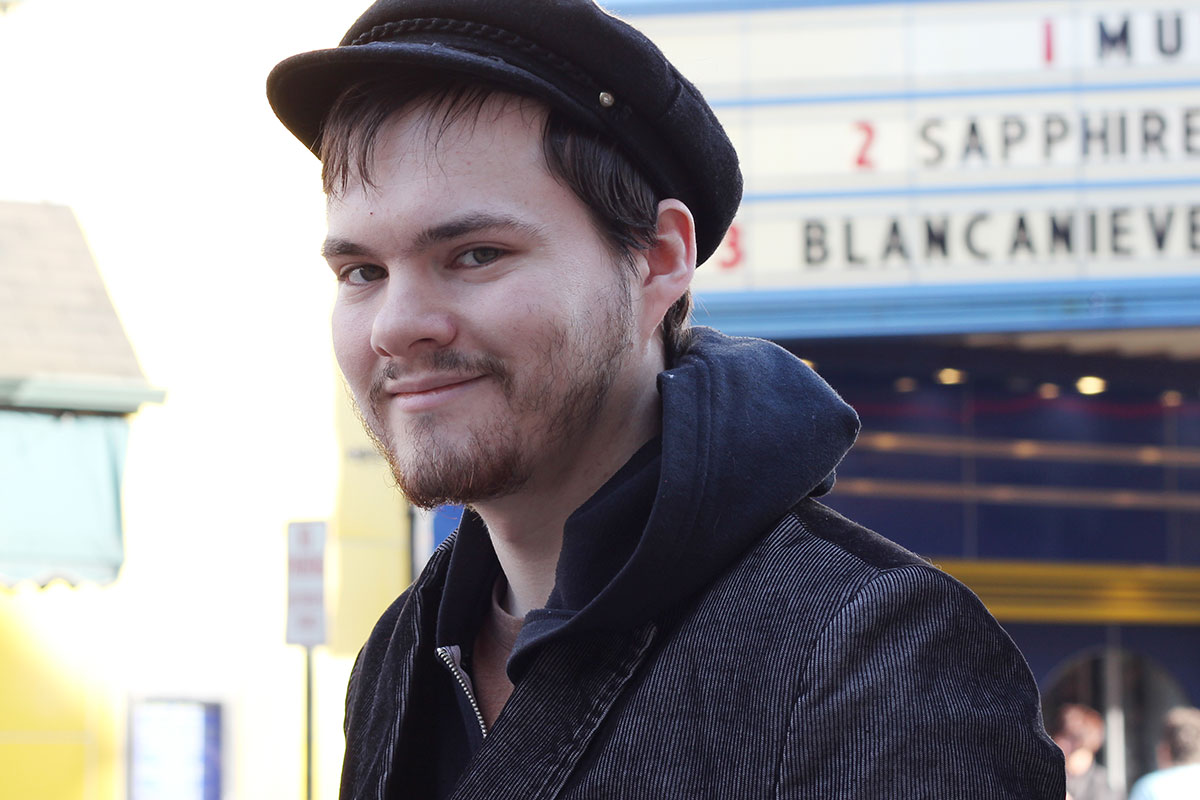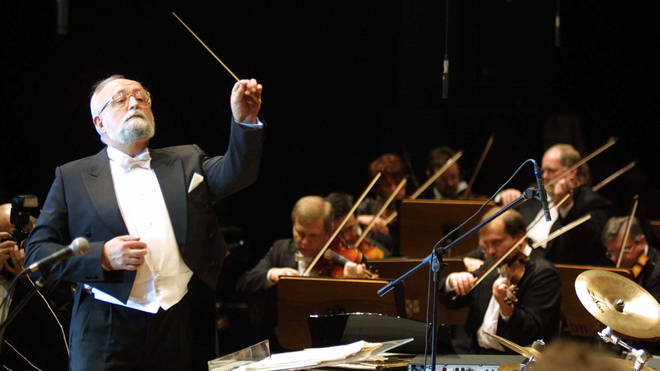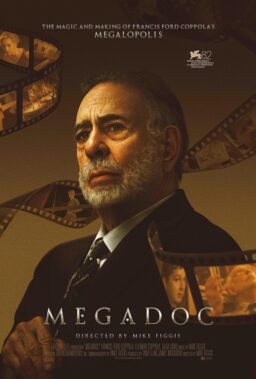Dębica, Poland sits only a few hours from the Ukrainian border, which meant it was in a precarious position in the early 1930s. When the Germans invaded, some of the sizable Jewish population fled for the Soviet controlled territories rather than wait for the Nazi rule to reshape the town. Many stayed behind and had their freedoms restricted a little at a time until finally they were forced into a ghetto constructed in 1942 and liquidated in 1943. The 1600 or so captives housed in the Dębica ghettos were sent to other camps around Poland. From his family’s house a few blocks from the ghetto in the center of town, a young Krzysztof Penderecki watched it all happen.
Penderecki’s family were protestant and catholic but they were nevertheless touched by the war in a hundred ways. His uncles were officers in the Polish army, killed by both the Germans and the soviets, one in the Katyn Massacre, when soviets rounded up some 22,000 Polish officers and killed them all summarily. Poland was a pawn in the war, invaded by Germany and then by Russia, which forced Britain to join the war. Poland suffered thousands of casualties and was not prepared to defend itself. Penderecki came of age with the creeping horror of the holocaust drifting over his home like a dread fog. Poland would take years to recover from the horror and destruction, and as it rebuilt itself, the young man would discover music.
In the films “Ida” and “Cold War” by Pawel Pawlikowski we witness the influence of Western music on those paralyzed by the Second World War. Jazz, rock & roll, experimental and avant-garde were introduced like new species into an endangered ecosystem after Poland rejected Stalinism and his cultural restrictions. Like the jazz-struck heroes of those movies, Penderecki took to Western music instantly, especially the stark strangeness of John Cage and early electronic music. He enrolled in the Academy of music in 1954 and when he graduated in 1958 began teaching and composing in his free time. It’s difficult to fathom now that it took only two years for Penderecki to become an indispensable force in modern Classical music. He premiered his pieces Strophen, Psalms of David, and Emanations in 1959, and 1960 changed the face of modern media with his piece 8′ 37″.
8′ 37″ was the length of the piece and no doubt a paean to Cage’s work 4′33″, in which the orchestra or musician playing the piece is quiet for that length of time, thus making the sound of the room and audience during the period the music of the piece. Just as Cage was attempting something radical in experimental music, a kind of Brechtian joke at the expense of the high brow, so too was Penderecki searching for new spaces in music theory. He later said he was attempting to create a new musical language, and indeed the techniques are bold and unprecedented. It was written for 52 string instruments and every part of their bodies was used. Musicians were encouraged to play behind the bridge of their violins, basses and cellos, or bow somewhere other than the strings. The result is quite unlike any piece of music before it. When he first heard the piece performed by the Krakow Philharmonic Symphony Orchestra, all he could think about was Hiroshima, the bomb, the horror of radiation and the destruction of the body. He retitled the piece Threnody for the victims of Hiroshima.
Penderecki’s development of a dissonant and churning foundational texture, the kind of undercarriage of his pieces, has precedent. His contemporary, the American composer Alan Hovhaness, for instance developed a similar language, and there are pronounced debts to Anton Webern & Igor Stravinsky among others. Penderecki’s music, beginning with Threnody, finds an idiom unique to his obsessions and his family history. His music, his famous use of tone clusters, encouraged to relive the tragedies of the 20th century. He begins writing choral music and opera in the ’60s, including his take on the oft quoted Dies Irae, which he dedicated to the victims of Auschwitz, and his opera The Devils of Loudon, and his work with the human voice is just as haunting as his experiments with string instruments. The dissonant harmonies, the wailing quality of his female lead vocals while woodwinds hum menacingly or squeak nervously behind them, this was choral music as only someone who had caught glimpses of Hell could have produced.
Penderecki became a sought after composer for short film and documentary in the ’60s after Threnody made waves all over the globe. His highest profile work during this period were his scores for the work of Wojciech Has, most notably his adaptation of Jan Potocki’s “The Saragossa Manuscript” in 1965. Alain Resnais asked him to score his time-jumping sci-fi tragedy “Je t’aime je t’aime” in 1968, as did New Wave minor leaguer Michel Cournot for his film “Les Gauloises Bleues.” Both films would have competed against each other at the 1968 Cannes Film Festival, if it hadn’t been cancelled midway through. In 1969, Rolf Liebermann made a film of his libretto “The Devils of Loudon” for German television, which had a pronounced impact on Ken Russell, the most operatic of filmmakers, who made his own version of the Aldous Huxley novel from which Penderecki took inspiration. Everywhere in his work was the shadow of violence, the voices in his work were mournful reminders of the silenced cries of the dead, left in mass graves without names or testimonies. Penderecki’s great musical project was to give voice back to those who had become statistics in mankind’s campaigns of warfare. His music returned humanity to those stripped of their identities by history’s crucibles of blood and power.
That was only the beginning of Penderecki’s influence on film. In 1973 William Friedkin was also out to change the language of a medium when he made “The Exorcist.” “The Exorcist” is one of the great works of manipulation in cinema, shoving us toward scares and revelations, daring us to look away as the devil and leagues of doctors and other professionals wage war on the body of a little girl. His then-groundbreaking strategy involved taking avant-garde compositions and laying them over both horrifying and banal passages of the movie to keep the viewer on edge. Famously he used Mike Oldfield’s song “Tubular Bells,” but more important to the nerve-shredding texture of the piece, he used some five pieces by Penderecki, dropping us in his viper’s nest of strings for a few seconds and then retreating to silence. If the film still gives people nightmares, Penderecki is to thank. A few years later, his work, along with Hector Berlioz, György Ligeti, and Béla Bartók would be used and adapted by Wendy Carlos for the immediately famous soundtrack to Stanley Kubrick’s “The Shining.” Both “The Exorcist” and “The Shining” would become classics that still endure decades after their releases. Their soundscapes and the judicious application of Penderecki’s music played no small part. The texture of horror films owe his orchestral approximation of nuclear fission a debt they could never repay.
Scraping violin sounds were not exactly new to horror movies when “The Exorcist” first dropped a needle on Penderecki’s early work. Bernard Herrmann had made violins sound like women screaming in his work for “Psycho” in 1960 (the same year Penderecki wrote Threnody), but there was something uniquely unnerving about the use of Penderecki’s modernist compositions that changed the game. It was the unyielding throng of sound, the way the music wasn’t designed for our emotions to fully make sense of the sounds. Placing Penderecki in film meant the music would not respond to the images, and indeed that these images would now echo with the real world terror he evoked. It is no small thing to use Penderecki’s music and few know how to get away with it. Among the successful employers are Peter Weir, David Lynch, Pablo Larrain, and Martin Scorsese. Lynch has used Penderecki more than once, indeed his movies and their famously oppressive sound designs make easy companions with the Polish composer, most famously employing Threnody during his dramatization of the atomic bomb testing in America during the eighth episode of “Twin Peaks: The Return.”
Penderecki was also a huge influence on in-demand composer Jonny Greenwood, the guitarist for the band Radiohead. His compositions for Paul Thomas Anderson’s “There Will Be Blood” and “The Master” bear Penderecki’s influence, specifically in his unconventionally percussive use of violins. They would later tour their compositions together and release an album of their work jointly. Penderecki was always open to changing tides in music, encouraging Greenwood and later working with Portishead’s Beth Gibbons. He was only too happy to allow the times to wend their way into his work. After all it was from history he drew his influences, and he was savvy enough to see Greenwood and Gibbons as part of it, no more or less important than any classical composer.
In 2007, he received one of his most important commissions from fellow Pole Andrzej Wajda, the famed chronicler of Polish history in his justly lauded films. Wajda was directing “Katyn,” based on the events surrounding the Katyn Massacre, which claimed the life of Penderecki’s uncle among the other thousands killed and buried. It was a way to close an important chapter in his life, to say something final about the events that had haunted his childhood and influenced his work as a composer. Penderecki’s legacy has been assured from nearly the moment he started composing a half a century ago. His music helped us reckon with the disastrous human rights violations that marked the middle of the 1900s, helped us hear cries made mute for the first time, turned the abstract toll of cruelty into something concrete. Something that still rings in our ears, and will always thunder in our memories. Krzysztof Penderecki was an artist only the 20th century could have produced, and in turn he shaped it into something more empathetic and something vastly more beautiful than seemed possible.












